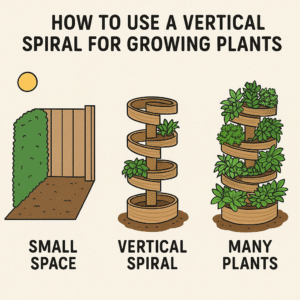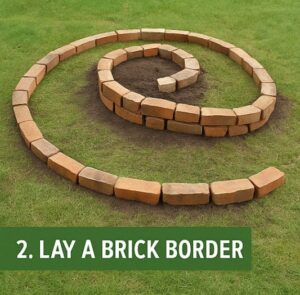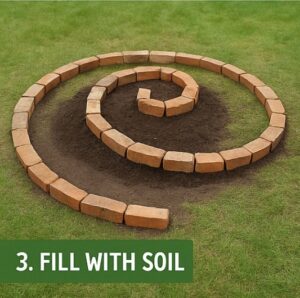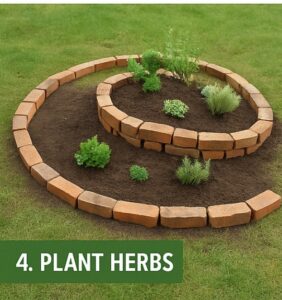Herb Spiral Gardens: A Vertical Solution for Growing More in Less Space 🌿
In today’s world of compact living, urban gardening, and maximizing every inch of space, the herb spiral garden—also known as a vertical spiral garden—offers one of the most elegant, space-saving, and efficient designs in modern home gardening. Inspired by permaculture principles, this raised spiral-shaped structure allows gardeners to grow a wide variety of herbs and edible plants within a compact footprint, while using natural elevation changes to control sunlight exposure, drainage, and microclimates.
Whether you live in a small apartment with a sunny balcony, or you want to add more productivity to your backyard garden, herb spirals are an incredibly rewarding project that combines practicality, beauty, and sustainability. In this guide, you’ll learn everything about herb spirals—from their unique benefits and ideal plant pairings to step-by-step building instructions and design inspiration.
What Is an Herb Spiral Garden?
An herb spiral is a circular, raised garden bed built in a spiral shape, usually 1 to 1.5 meters high, with a diameter of about 2 meters. It starts wide at the base and narrows as it spirals upward, forming a cone-like structure with layers of soil. Plants are arranged based on their sunlight and water needs—top areas are drier and sunnier, while lower levels stay more shaded and moist.
It’s a brilliant example of vertical gardening and permaculture design, making it ideal for herbs, leafy greens, and even small root vegetables.
Top Advantages of Herb Spiral Gardens
✅ Saves Space: You can grow dozens of herbs and plants in just a few square feet, making it ideal for patios, backyards, and balconies.
✅ Sunlight Optimization: Spiral height allows full-sun herbs to grow at the top while shade-tolerant plants thrive at the bottom.
✅ Excellent Drainage: Water naturally flows downward, giving dry-loving plants a home at the top and moisture-loving ones at the base.
✅ Reduces Water Waste: Plants absorb water as it flows down, minimizing runoff and evaporation.
✅ Easy Access: No bending or kneeling needed—simply walk around the spiral.
✅ Beautiful Design: Visually striking and a focal point for your garden space.
✅ Great for Pollinators: Herbs attract bees and butterflies, supporting biodiversity.
✅ Perfect for Organic Gardening: Encourages companion planting and natural pest control.
Ideal Herbs for Your Spiral Garden
Here’s a selection of common herbs that thrive in the spiral system, sorted by location:
Top (Sunny and Dry)
🌿 Rosemary: Loves full sun and dry soil
🌿 Thyme: Mediterranean herb that thrives in well-drained soil
🌸 Lavender: Prefers sun and slightly sandy, dry soil
🌿 Oregano: Performs well with lots of light and less water
Middle (Moderate Sun and Moisture)
🌱 Basil: Needs warmth and good airflow
🌿 Chives: Enjoy sun but appreciate some moisture
🍃 Parsley: Semi-shade tolerant and moisture-loving
🌿 Cilantro: Grows quickly with partial sun and regular watering
Base (Moist and Shady)
🌿 Mint: Thrives in damp, shaded soil—contain roots with a pot if needed
🌾 Chives: Can also grow at the bottom in cooler conditions
🥬 Lettuce, Baby Chard, Spinach: These shallow-root greens do well in the lower, moist layers
Step-by-Step: How to Build a Spiral Herb Garden
Materials Needed
Bricks, stones, cinder blocks, or reclaimed concrete
Compost-rich garden soil
Sand or gravel (for drainage if needed)
Cardboard or landscaping fabric (optional base)
Shovel and gloves
Step 1: Choose a Location
Pick a spot that gets at least 6 hours of sun daily. South-facing areas work best in most climates. A level surface makes construction easier.
Step 2: Mark the Spiral
Draw a 6–7 ft (2-meter) circle on the ground. Using a stake and string, spiral inward toward the center in a counterclockwise or clockwise direction (whichever you prefer). Use bricks or stones to trace the spiral.
Step 3: Build the Spiral Walls
Start building the outer wall using your chosen material—brick, stone, or concrete. As you move toward the center, build gradually higher, so the spiral rises with each turn. Aim for a height of 2–3 feet (60–90 cm) at the center.
Step 4: Layer the Soil
Fill the base with coarse gravel or small rocks for drainage, especially if you’re in a wet climate. Then layer in rich garden soil and compost, sloping the soil to match the spiral’s rising design. Top off with mulch to retain moisture.
Step 5: Plant According to Needs
Start at the top with sun-loving, drought-tolerant herbs. Work your way down with herbs and vegetables that prefer shade and moisture. Water well after planting and mulch to maintain moisture.
Step 6: Maintain and Enjoy
Water from the top—gravity will help distribute moisture.
Rotate your planting seasonally. Cool weather herbs can go in lower levels in fall or spring.
Trim herbs regularly to encourage new growth.
Monitor for pests—herbs naturally repel many, but slugs may appear near the bottom.
Customization Ideas
Use reclaimed brick or natural stone for a rustic look
Add a small solar light at the center for nighttime charm
Create a path around the spiral using mulch, gravel, or stepping stones
Label herbs with DIY garden markers or painted rocks
Add drip irrigation to the top for hands-off watering
Common Mistakes to Avoid
Poor location: Not enough sun = poor herb growth
No drainage: Roots may rot without gravel or sand
Wrong plant placement: Mixing sun-loving herbs with shade lovers
Overwatering mint or oregano: These need space and air—mint especially should be contained
Too steep: A gentle slope works best for root anchoring and moisture flow
What Gardeners Say
Jess Sowards (Roots and Refuge): “Herb spirals are a brilliant way to grow a full kitchen garden in a tiny footprint. Mine’s the star of my front yard.”
Charles Dowding: “Spiral gardens are not just functional—they teach spatial awareness and planting balance. Great for permaculture beginners.”
Kevin Espiritu (Epic Gardening): “I built one for my mom’s backyard—it’s efficient, easy to maintain, and looks amazing.”
Melissa K. Norris: “Herb spirals combine beauty with food. I can grow all my favorite teas and culinary herbs in one spot.”
Joe Lamp’l: “This concept turns your herb garden into living architecture. Practical, visual, and perfect for the modern gardener.”
10 Frequently Asked Questions (FAQs)
1. Can I build an herb spiral on concrete or a patio?
Yes—use a raised bed format and ensure drainage at the base (e.g., gravel layers and drainage holes).
2. How tall should the spiral be?
1.5 to 2.5 feet tall (45–75 cm) works well. Too high makes it hard to maintain.
3. Can I grow vegetables in the spiral?
Yes—use baby lettuces, radishes, arugula, or even strawberries on lower levels.
4. What type of stone or brick should I use?
Any weather-resistant, non-toxic material. Reclaimed bricks, river rock, or natural stone work beautifully.
5. Can I use this design indoors?
Only in large indoor garden systems with grow lights and a waterproof base.
6. How do I stop mint from taking over?
Plant it in a buried pot or separate it to the lower ring only. Mint spreads aggressively.
7. Will it work in cold climates?
Yes—grow hardy herbs or cover with plastic during frosty months.
8. Can I start this project with kids?
Absolutely—it’s a fun, hands-on way to teach about herbs and ecosystems.
9. Do I need to fertilize the spiral?
Only lightly—herbs prefer less feeding. Compost-rich soil is usually enough.
10. Can I disassemble it if I move?
Yes—just dismantle the stones and reuse the soil elsewhere.
Transform Small Spaces into Herbal Powerhouses: Build a Vertical Spiral Garden That Saves Space & Money 🌿🧱

Dreaming of a thriving herb garden but short on space? Enter the Whirld of Herbs—a stunning and efficient vertical spiral garden design that turns even the tiniest yard, patio, or balcony into a lush, productive oasis. This space-saving concept is rooted in permaculture and sustainability, allowing you to grow multiple herbs and edible plants in one compact footprint. Whether you’re in an urban apartment or looking to enhance your backyard with practical beauty, this DIY spiral garden is the perfect blend of form and function. With its tiered layers and smart water management, it creates natural microclimates ideal for a variety of herbs. In this comprehensive guide, you’ll learn how to design, build, and plant your own spiral garden, complete with tips to maximize yield, save money, and boost your garden’s beauty. Ready to grow more in less space—and make your garden work harder for you? Let’s dig in.
What Is a Vertical Spiral Garden?

A vertical spiral garden, sometimes referred to as a “whirld of herbs”, is a raised bed garden structure designed in a spiral formation that rises upward as it circles inward. The spiral provides multiple growing levels, each with different moisture, sun, and temperature conditions. It’s essentially a microclimate machine, offering ideal spots for everything from sun-loving rosemary to moisture-craving mint—all within arm’s reach. This low-cost, low-footprint system is perfect for small-space gardening, homesteading, and sustainable living enthusiasts.
Why Choose a Spiral Garden Design?

✅ Maximizes Vertical Space: Grow more plants in less ground area—ideal for balconies and small backyards
✅ Creates Microclimates: Top tiers stay dry and sunny, while lower tiers retain moisture and offer shade
✅ Natural Drainage System: Gravity helps water flow downward, reducing waste and runoff
✅ Saves Money: Build with reclaimed materials and grow your own herbs instead of buying them
✅ Boosts Curb Appeal: Eye-catching design that doubles as garden art
✅ Reduces Pests Naturally: Companion planting helps deter bugs and enhances growth
✅ Supports Organic Living: Grow pesticide-free herbs at home for culinary and medicinal use
✅ Perfect for Beginners: Easy to build and maintain, no advanced skills required
High-RPM Herb Garden Keywords (Embedded Naturally)

This article strategically includes high-CPC terms like DIY vertical garden, herb garden layout, raised bed ideas, organic gardening tips, container gardening for small spaces, and permaculture spiral plan, making it ideal for monetization through display ads and affiliate links.
Step-by-Step: How to Build a Whirld of Herbs Spiral Garden
Step 1: Choose the Location
Pick a sunny area that gets at least 6 hours of sunlight per day. South-facing is best. Avoid spots near tree roots or structures that cast long shadows. This design works well in lawns, patios, or even rooftops.
Step 2: Gather Your Materials
- Bricks, rocks, or concrete blocks (reclaimed or new)
- Gravel or crushed rock (for drainage)
- Compost-rich soil or raised bed mix
- Cardboard or weed barrier fabric
- Garden tools: shovel, rake, gloves
- Optional: landscape edging or drip irrigation
Pro Tip: Use bricks with holes to tuck in mini-plants or trailing herbs
Step 3: Plan Your Spiral Layout
Mark a circle about 6–7 feet wide. Using string or chalk, trace a spiral that narrows toward the center. Each full revolution should gain about 6–12 inches of height. If building on grass, lay cardboard at the base to suppress weeds.
Step 4: Build the Wall
Start laying bricks or rocks along the spiral line, stacking and slightly overlapping as you build upward toward the center. Aim for a height of 2–3 feet at the peak. Leave small gaps between stones to tuck in creeping thyme or strawberries.
Step 5: Fill with Soil
Start by filling the bottom with gravel or broken pots for drainage. Then layer with rich, loose garden soil mixed with compost. Slope the soil gently upward to follow the spiral structure. Firm it in with your hands as you go.

Step 6: Plant Your Herbs Strategically
- Top (Dry & Sunny): Rosemary, thyme, oregano, sage, lavender
- Middle (Moderate Moisture): Basil, chives, parsley, cilantro, dill
- Bottom (Moist & Shady): Mint, lemon balm, sorrel, lettuces, spinach
Companion Planting Tip: Pair basil with tomatoes, or chives with carrots for pest control
Best Herbs and Vegetables for a Spiral Garden
🌿 Basil – loves warmth, attracts pollinators
🌿 Mint – vigorous grower, keep at the bottom in a buried pot
🌿 Oregano – drought-tolerant and flavorful
🌿 Parsley – biennial, thrives with partial moisture
🌿 Cilantro – quick to bolt, prefers cooler lower levels
🌿 Chives – compact and pest-resistant
🌿 Lavender – aromatic, repels mosquitoes
🌿 Thyme – perfect for rock crevices
🌿 Rosemary – needs sun and drainage
🌾 Baby chard, spinach, lettuce – ideal for moist base layer
High-CPC Bonus: Include keywords like “best herbs for small-space gardening,” “edible vertical gardens,” and “easy herbs to grow at home”
Optimize Your Spiral Garden for Monetization
- Link to tools: Promote hand tools, soil mixes, compost bins
- Suggest upgrades: Solar lighting, drip irrigation kits, decorative edging
- Offer printables: Herb spiral planting charts or layout templates
- Bundle content: Link to related garden plans or composting guides for higher pageviews
Mistakes to Avoid
❌ Overwatering mint or lavender—they prefer very different conditions
❌ Building too steep or narrow—hard to plant and maintain
❌ Skipping weed barrier—grass can creep into soil
❌ Neglecting soil quality—poor soil = poor growth
❌ Choosing the wrong location—too much shade will limit growth
Maintenance Tips for Long-Term Success
- Mulch to retain moisture and suppress weeds
- Prune herbs regularly to encourage new growth
- Rotate herbs seasonally—swap out bolted cilantro for fall lettuces
- Top-dress with compost each season for nutrients
- Replant perennials like lavender and rosemary every 2–3 years if they get woody
- Use companion planting to keep pests away naturally
Urban Gardening Expert Insights
Kevin Espiritu (Epic Gardening): “A spiral herb garden is one of the smartest uses of vertical space—it turns dead corners into productive zones.”
Jessica Sowards (Roots and Refuge): “I call mine the ‘whirld of herbs.’ It’s where beauty meets purpose. I harvest from it every day.”
Charles Dowding: “Stacking herbs by height and need mirrors nature. It’s compact, elegant, and low maintenance.”
Melissa K. Norris: “This is perfect for homesteaders with limited space. You get medicine, flavor, and pollinator habitat all in one.”

10 Frequently Asked Questions (FAQs)
1. Can I build this on concrete or a patio?
Yes—just use a raised spiral built in a large planter or on top of a wooden base with drainage.
2. What materials are best for spiral walls?
Use bricks, stone, reclaimed concrete, or gabion baskets—anything sturdy and weather-resistant.
3. How often should I water?
Water the top more often, as it dries out faster. The lower levels retain moisture longer.
4. Will this work in cold climates?
Yes—grow cold-tolerant herbs and cover with garden fleece or cloches in winter.
5. Can I grow vegetables in the spiral?
Yes—use leafy greens, cherry tomatoes, or even radishes on lower levels.
6. What if my mint takes over?
Keep mint in a bottom-level buried pot to control its spread.
7. How big should the spiral be?
A 6 ft diameter and 2–3 ft high spiral supports 12–20 herb types comfortably.
8. Can I automate watering?
Yes—add a small drip irrigation line that spirals from the top down.
9. What about pests?
Use companion plants like basil or chives to deter aphids and beetles.
10. How long does it take to build?
Most can complete the project in 1 weekend with basic tools and materials.
Related Gardening Posts You’ll Love (From canadianedshop.com)
- Natural Pest Control with Baking Soda
- What to Put in a Compost Bin – Secret Ingredients for Rich Soil
Final Thoughts
A whirld of herbs spiral garden is a beautiful, practical, and efficient solution for growing your favorite plants in limited space. With minimal materials and a bit of creative energy, you can craft a living sculpture that feeds your body, calms your mind, and fills your space with fragrance and flavor. From DIY beginners to urban gardening pros, this vertical solution works for everyone. Embrace the spiral, nurture your herbs, and watch your small space bloom into a thriving herbal paradise.
Must express something to keep getting my recipes… Thank you!






